Geography Reference
In-Depth Information
Figure 11.4 depicts the global distribution of plant
domestication hearths. In Southeast Asia (Region 1), taro,
yams, and bananas were the leading food plants. In
Southwest Asia (Region 4), plant domestication centered
on wheat, barley, and other grains. In the Mesoamerican
region (Region 6), the basic plants were maize (corn),
squashes, and several kinds of beans.
Archaeologists continually fi nd new sites to excavate,
and as places are analyzed further, academics revise their
assumptions about the timing of the emergence of agricul-
tural hearths. The Central China hearth (Region 7) has
recently attracted greater attention because new evidence
supports a much earlier development of agriculture in this
region—so early, in fact, that Chinese farmers may have
been among the world's fi rst. Another agricultural source
region lies in West Africa (Region 9). Archaeological
research on agriculture in this area is relatively recent, and
analysts are not certain whether agriculture developed
independently there.
Table 11.1 may be overwhelming at fi rst glance, but
it is worth careful attention. It reveals the enormous range
of crops that were cultivated around the world, as well as
how, at various times and in different locales, particular
groups of crops became the mainstays of life. Soon the
knowledge needed to farm such crops diffused outward
from these agricultural hearths. For example, both millet
and sorghum diffused from the West African region—
millet to India and sorghum to China.
In many cases, what we now think of as centers of
production of particular crops are not the places where
those crops were originally domesticated. The corn
(maize) we associate with the American Corn Belt diffused
from Mesoamerica (Region 6) into North America. Later,
the Portuguese brought it across the Atlantic, and corn
became a staple in much of Africa. The white potato we
associate with Ireland and Idaho came originally from the
Andean highlands but was brought to Europe in the 1600s
where it became a staple from Ireland to the eastern
expanses of the North European Plain. The banana we
associate with Mesoamerica came from Southeast Asia, as
did a variety of yams. Diffusion of crops and seeds was
greatly accelerated by worldwide trade and communica-
tions networks established with the development of mer-
cantilism and European colonialism.
Domestication of Animals
Some scholars believe that animal domestication began
earlier than plant cultivation, but others argue that animal
domestication began as recently as 8000 years ago—well
after crop agriculture. Whichever is the case, goats, pigs,
and sheep became part of a rapidly growing array of domes-
ticated animals, and in captivity they changed considerably
from their wild state. As with the growing of root crops, the
notion of
animal domestication
must have emerged over
time, in stages.
Figure 11.4
World Areas of Agricultural Innovations.
Cultural geographer Carl Sauer identifi ed 11
areas where agricultural innovations occurred.
Adapted with permission from:
C. O. Sauer,
Agricultural Origins
and Dispersals.
New York: American Geographical Society, 1952, p. 24.
Arctic
Circl
e
6
0°
60°
ATLANTIC
PACIFIC
40°
40°
40°
40°
ATLANTIC
OCEAN
OCEAN
8
4
OCEAN
7
PACIFIC
Tropic of Cancer
Tropic of Cancer
20°
20°
20°
20°
3
1
OCEAN
9
6
INDIAN
OCEAN
5
2
WORLD AREAS OF
AGRICULTURAL INNOVATIONS
1. Upper Southeast Asian Mainland
2. Lower Southeast Asian Mainland and Ma
lay
sia
3. Eastern India and Western Myanmar
4. Southwestern Asia
(Northwest India-Caucasus)
5. Abyssinian and East African Highlands
6. Mesoamerican Region
(Southern Mexico to Northern Venezuela)
7. North Central China
(including the Central Asian Corridor)
8.
Mediterranean Basin-Class
ical Near Eastern Fringe
9. Western Sudan Hill Lands and their Margins
10. Andean Highlands and their Margins
11. E
astern South A
merica
(centered on Eastern Brazil)
0°
Equator
Equator
0°
10
ATLANTIC
20°
20°
20°
20°
20°
20°
20°
20°
11
Tropic of
Capricorn
Tropic of Capricorn
OCEAN
40°
40°
40°
40°
40°
40°
160°
140°
120°
80°
60°
40°
0°
20°
40°
60°
100°
120°
140°
160°
60°
60°
60°
60°
60°
60°
60°
60°
Antarctic Circle






























































































































































































































































































































































































































































































































































































































































































































































































































































